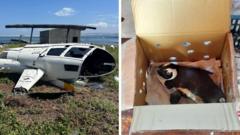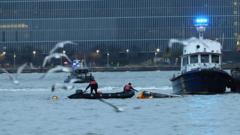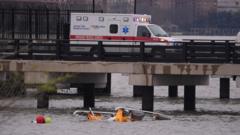An investigation has revealed that an "unsecured" penguin nestled in a cardboard box was the unexpected catalyst for a helicopter crash in South Africa earlier this year. The incident occurred on January 19, shortly after take-off from Bird Island, off the Eastern Cape. According to the South African Civil Aviation Authority (SACAA), the penguin, which had been precariously placed on a passenger’s lap, slipped off and impacted the pilot’s controls. This caused the helicopter to lose control and crash, although fortunately, no injuries were reported among the occupants or the penguin itself.
Penguin Mishap Leads to Helicopter Crash in South Africa

Penguin Mishap Leads to Helicopter Crash in South Africa
A loose penguin disrupts flight, causing an unexpected helicopter accident with no injuries.
The report, released earlier this week, detailed how the helicopter was conducting an aerial survey before the unfortunate incident. After the survey was completed, a request was made to transport the penguin back to Port Elizabeth, though the reason for its retrieval was not disclosed. The SACAA noted that the pilot had performed a risk assessment prior to take-off but failed to account for the presence of the penguin, which contravened Civil Aviation Regulations (CAR) enacted in 2011.
As the helicopter ascended to about 15 meters, the cardboard box shifted from the passenger's lap and collided with the cyclic pitch control lever, sending it to a fully-rotated position. This caused the helicopter to roll uncontrollably before the rotor blades struck the ground and led to the crash, approximately 20 meters from the lift-off point. The damage to the helicopter was substantial, yet thankfully, the pilot, passengers, and the penguin emerged from the situation unharmed.
The investigation concluded that all flights are subject to established safety protocols, asserting the necessity for proper containment for cargo—especially in unusual circumstances like transporting a penguin. The absence of a secure crate during flight was deemed a significant oversight, with recommendations made to ensure stringent compliance with aviation safety procedures moving forward.
This incident underscores the importance of adhering to established safety standards in aviation, even in circumstances featuring unconventional cargo.
As the helicopter ascended to about 15 meters, the cardboard box shifted from the passenger's lap and collided with the cyclic pitch control lever, sending it to a fully-rotated position. This caused the helicopter to roll uncontrollably before the rotor blades struck the ground and led to the crash, approximately 20 meters from the lift-off point. The damage to the helicopter was substantial, yet thankfully, the pilot, passengers, and the penguin emerged from the situation unharmed.
The investigation concluded that all flights are subject to established safety protocols, asserting the necessity for proper containment for cargo—especially in unusual circumstances like transporting a penguin. The absence of a secure crate during flight was deemed a significant oversight, with recommendations made to ensure stringent compliance with aviation safety procedures moving forward.
This incident underscores the importance of adhering to established safety standards in aviation, even in circumstances featuring unconventional cargo.



















